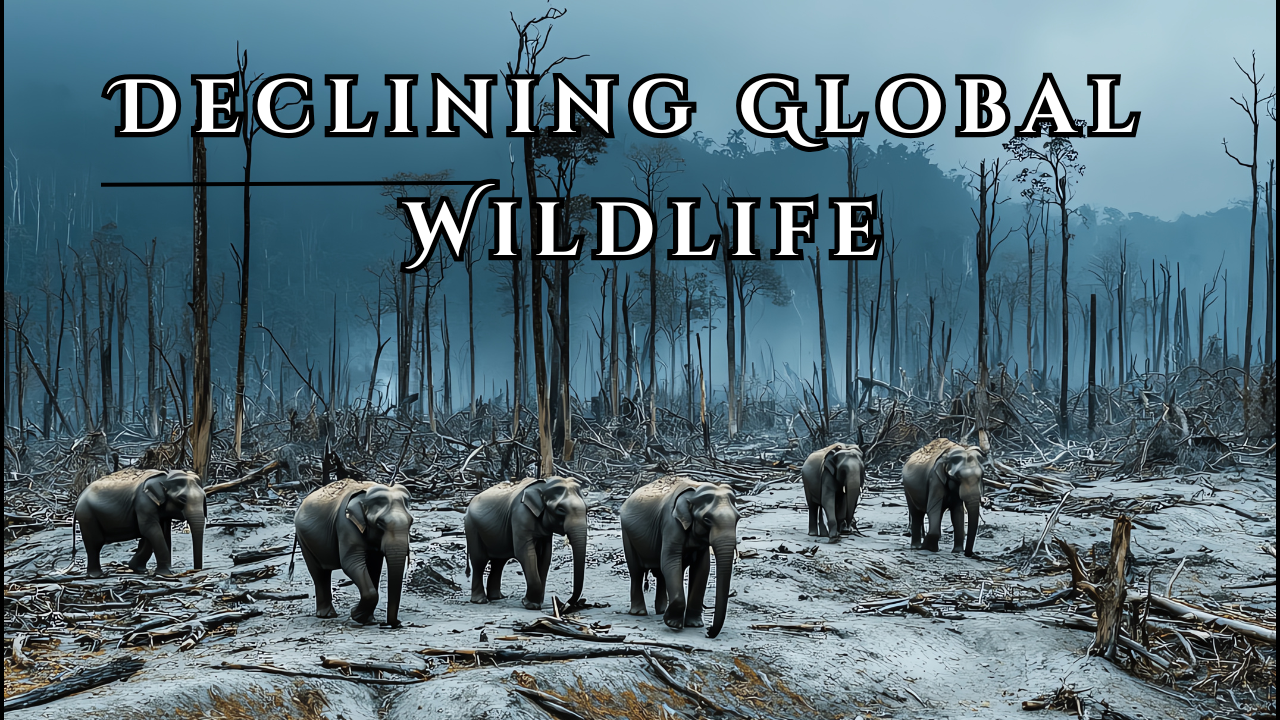Declining Global Wildlife
Context:Declining Global Wildlife
According to the World Wide Fund for Nature’s (WWF) Living Planet Report (LPR) 2024, global wildlife populations have declined by an average of 73% between 1970 and 2020.
Key Findings of the Report:
- Compilation: The report’s Living Planet Index (LPI), compiled by the Zoological Society of London (ZSL), tracks the population trends of nearly 35,000 wildlife populations across 5,495 species.
- Decline: This marks a significant drop from the 69% decline reported in the 2022 edition.
- The steepest declines were observed in freshwater ecosystems, which have experienced an 85% reduction, followed by terrestrial ecosystems at 69% and marine ecosystems at 56%.
- Decline of Vultures: The report also highlighted the severe decline in three vulture species in India—white-rumped vulture (Gyps bengalensis), Indian vulture (Gyps indicus), and slender-billed vulture (Gyps tenuirostris).
- A 2022 nationwide vulture survey by the Bombay Natural History Society (BNHS) revealed that the white-rumped vulture population has declined by 67%, the Indian vulture by 48%, and the slender-billed vulture by 89% since 2002.
- Primary Threats: The primary threats stem from habitat loss and degradation. Over-exploitation, invasive species, diseases, and pollution—especially in Asia and the Pacific, where a 60% decline has been recorded—further contribute to the decline.
- Implications: Wildlife population declines serve as early warning signs of increased extinction risks and the degradation of healthy ecosystems.
- Damaged ecosystems are more vulnerable to tipping points, where they may cross critical thresholds and undergo potentially irreversible changes.
- Recovery: Some species in India, such as tigers, have shown recovery due to successful conservation efforts.
- The All-India Tiger Estimation 2022 recorded 3,682 tigers, a notable increase from 2,967 in 2018.
- Need of the Hour: While global agreements like the Global Biodiversity Framework, the Paris Agreement, and the UN Sustainable Development Goals aim to halt and reverse nature loss, limit global warming to 1.5°C, and eradicate poverty, the report cautions that current national actions fall far short of what is needed to meet these targets by 2030 and avert dangerous tipping points.
- The report underscores the urgent need for “collective effort” over the next five years to address the dual crises of climate change and biodiversity loss.
World Wildlife Fund (WWF)Originally known as the World Wildlife Fund for Nature, it is a leading international non-profit organisation dedicated to wildlife conservation and environmental protection. Founded on April 29, 1961, and headquartered in Gland, Switzerland, WWF is recognised as one of the largest conservation organisations globally, supporting over 1,000 projects across various ecosystems. Key Initiatives:
|
Causes of Declining Wildlife Populations:
- Habitat Loss and Degradation: Urbanisation, agriculture, and deforestation lead to significant habitat destruction.
- This is responsible for approximately 31.4% of wildlife loss.
- Overexploitation: Unsustainable hunting and fishing practices contribute to about 37% of biodiversity loss.
- Invasive Species: Non-native species disrupt local ecosystems, accounting for around 5.1% of wildlife loss by outcompeting native species.
- Pollution: Contaminants in air, water, and soil negatively impact wildlife health and habitats, contributing to about 4% of biodiversity loss.
- Climate Change: Altered weather patterns and rising temperatures threaten species’ survival and habitat viability.
Implications of Wildlife Decline:
- Ecosystem Health: Declines in wildlife populations signal broader ecosystem degradation, increasing extinction risks and reducing ecosystem resilience.
- Human Well-being: The loss of biodiversity can lead to economic instability, affecting industries reliant on natural resources.
- Tipping Points: Ecosystems may reach critical thresholds beyond which recovery becomes impossible, leading to irreversible changes in environmental conditions.
Steps Taken by India:
- Legal Frameworks:
- Wildlife Protection Act (1972): This landmark legislation provides for the protection of wild animals, birds, and plants.
- Fisheries Act (1897) and Indian Forests Act (1927): These earlier laws laid the groundwork for wildlife conservation by regulating fishing and forest use, respectively.
- Protected Areas: Establishment of Protected Areas: India has created a network of 870 protected areas, which includes 551 wildlife sanctuaries, 104 national parks, and various conservation reserves. This network covers approximately 5.06% of India’s total geographical area.
- Conservation Programs:
- Project Tiger: Launched in 1973, this initiative aims to protect tiger populations and their habitats through a dedicated conservation strategy.
- Project Elephant: Established in 1992 to safeguard elephant habitats and migratory routes.
- Integrated Development of Wildlife Habitats: This scheme includes a component for the Recovery of Endangered Species, focusing on species such as the Snow Leopard and Indian Rhinoceros.
- Anti-Poaching Measures:
- Wildlife Crime Control Bureau (WCCB): Formed to combat illegal wildlife trade and coordinate enforcement efforts among various agencies.
- Anti-Poaching Squads: Special forces have been deployed in critical areas to enhance patrolling and surveillance against poaching activities.
- Research and Education:
- Support for Research Organisations: Institutions like the Wildlife Institute of India and the Bombay Natural History Society conduct essential research on wildlife conservation strategies.
- Public Awareness Campaigns: Efforts are made to educate the public about the importance of wildlife conservation, fostering a culture of respect for nature.
- International Cooperation: India has engaged in international collaborations with neighbouring countries like Nepal and Bangladesh to tackle issues related to illegal wildlife trade and to enhance conservation efforts for shared species like tigers and leopards.
- Recent Initiatives: E-Surveillance Technologies, implemented in key national parks such as Kaziranga National Park to monitor wildlife movements and deter poaching through technological advancements.
Way Forward:
- Collective Global Action: There is an urgent need for coordinated efforts among governments, businesses, and communities.
- Investment in Conservation: Increased funding for conservation projects is essential to restore habitats and protect endangered species.
- Public Awareness Campaigns: Educating communities about the importance of biodiversity can foster grassroots support for conservation initiatives.
- Sustainable Practices: Transitioning towards sustainable agricultural and industrial practices can mitigate habitat destruction and overexploitation.
Subscribe to our Youtube Channel for more Valuable Content – TheStudyias
Download the App to Subscribe to our Courses – Thestudyias
The Source’s Authority and Ownership of the Article is Claimed By THE STUDY IAS BY MANIKANT SINGH





